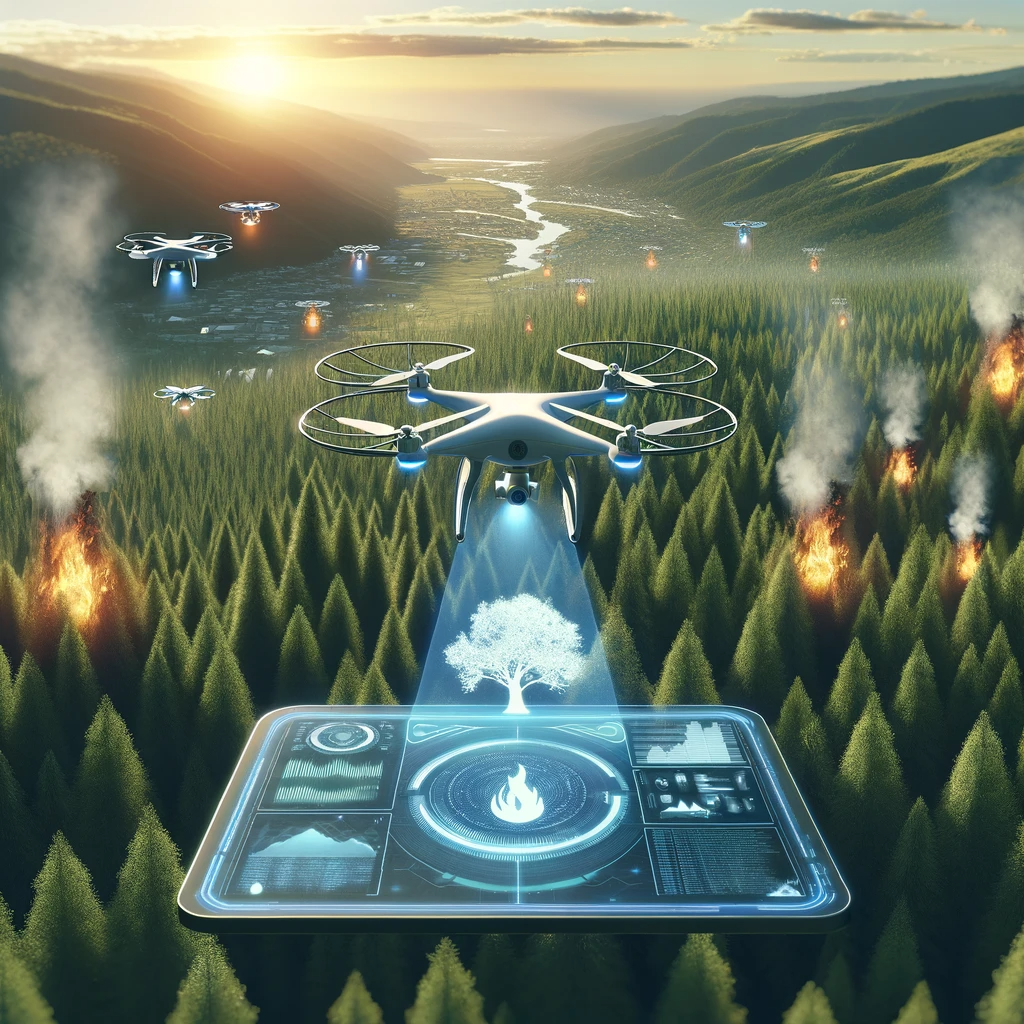The haunting images of raging wildfires, consuming vast expanses of pristine forests, have become all too familiar in recent years. These destructive infernos not only pose a grave threat to the delicate balance of ecosystems but also endanger the lives and livelihoods of those living in their path. In an era marked by the growing menace of forest fires, the need for proactive measures to detect and combat them has never been more pressing.
The devastating impact of forest fires extends far beyond the immediate destruction they cause. They leave ecological scars, obliterate habitats, release copious amounts of greenhouse gases into the atmosphere, and imperil the safety of communities nestled amidst the woodlands. Traditional methods of forest fire detection, while valiant, often fall short in providing timely alerts, leaving responders with limited time to react.
This article embarks on an exploration of a transformative solution to this escalating crisis: the role of Artificial Intelligence (AI) in early detection of forest fires. In a world where the frequency and intensity of wildfires are on the rise, AI emerges as a formidable ally in monitoring forest conditions, predicting the onset of fires, and enabling swift response measures.
Our journey into the realm of AI and forest fire detection will delve into the rising challenge of wildfires, the limitations of traditional detection methods, and the promising potential of AI-powered solutions. We will uncover how AI systems collect and analyze data from various sources to identify early indicators of wildfires, and how they facilitate real-time monitoring and alerts to authorities and communities at risk.
In a field fraught with challenges and complexities, we will also examine the hurdles that AI must overcome to fulfill its potential in forest fire prevention. False alarms, data accuracy, and the need for continued research and development are among the obstacles that require vigilant attention.
As we peer into the future, we will speculate on the evolving role of AI in forest fire prevention and management. The symbiotic relationship between technology and ecology holds the promise of a world where wildfires are not only detected early but also managed with greater efficiency, minimizing their ecological and human toll.
This article is a testament to the remarkable synergy between human innovation and the urgent need for environmental stewardship. Join us on this journey into the heart of AI’s transformative impact on forest fire detection, where technology and nature unite to protect our forests and the communities that rely on them.
The Rising Challenge of Forest Fires
In recent years, the global landscape has been marred by an alarming increase in the frequency and intensity of forest fires. These infernos, fueled by a combination of climate change, drought, and human activities, have left an indelible mark on ecosystems, landscapes, and human communities. The consequences of forest fires extend far beyond the immediate devastation they bring.
Forest fires disrupt delicate ecosystems, causing habitat destruction and the loss of biodiversity. The destruction of vegetation exposes soil to erosion, leading to the degradation of vital natural resources. Additionally, the vast plumes of smoke generated by wildfires release copious amounts of greenhouse gases into the atmosphere, contributing to climate change.
However, perhaps the most immediate and visceral impact of forest fires is felt by the communities that reside in or near forested areas. Homes and livelihoods are threatened, and in some tragic cases, lives are lost. The economic toll of fighting wildfires and the costs of rehabilitation run into billions of dollars annually.

Traditional Fire Detection Methods
To combat the growing menace of forest fires, societies have long relied on traditional methods of fire detection. These methods include the use of lookout towers, human patrols, and satellite imagery. While these approaches have played a crucial role in fire management, they are not without their limitations.
Lookout towers, for instance, provide vantage points from which fires can be spotted, but they are dependent on human observers who may not be vigilant around the clock. Satellite imagery can detect large fires but may not provide timely alerts for smaller, fast-spreading fires that can quickly escalate.
Moreover, the allocation of resources for ground patrols and aerial surveillance can be costly and challenging to scale effectively, especially in vast and remote forested areas. As the scale and impact of forest fires increase, there is an urgent need for more efficient and technologically advanced methods of fire detection.
The Promise of AI in Forest Fire Detection
Artificial Intelligence (AI) emerges as a beacon of hope in the realm of forest fire detection. This transformative technology has the potential to revolutionize the way we monitor forest conditions, predict the onset of fires, and enable rapid response measures.
At the heart of AI’s promise in this domain lies its ability to process and analyze vast amounts of data from diverse sources in real-time. AI algorithms can sift through data collected from satellites, drones, ground-based sensors, weather stations, and historical fire records with unprecedented speed and precision.
AI’s real strength lies in its capacity to identify patterns, anomalies, and early indicators of potential wildfires. By examining a multitude of factors, such as temperature, humidity, wind speed, and vegetation health, AI can discern subtle changes that may precede the ignition of a fire. This predictive modeling capability holds the key to early detection and prevention, potentially saving lives and ecosystems.
AI-Powered Data Collection and Analysis
The foundation of AI’s effectiveness in forest fire detection lies in its ability to collect and analyze data from an array of sources. Drones equipped with specialized sensors can provide real-time imagery and environmental data from the heart of forests. Ground-based sensors can monitor conditions at the micro level, detecting heat anomalies or changes in moisture levels that might signify a fire’s emergence.
Weather stations contribute critical data, enabling AI to assess meteorological conditions and their potential impact on fire risk. Satellite imagery, with its wide coverage, offers a bird’s-eye view of vast forested regions, allowing AI to detect fires as soon as they ignite.
AI-driven systems integrate data from these diverse sources, creating a comprehensive and dynamic picture of forest conditions. Machine learning algorithms continuously analyze this data, learning from historical patterns and adapting to evolving environmental factors. This comprehensive data collection and analysis are pivotal in AI’s ability to provide early and accurate warnings of potential forest fires.
The transformative potential of AI in early forest fire detection is just beginning to unfold. As we continue our exploration, we will delve deeper into how AI facilitates real-time monitoring and alerts, providing a critical advantage in responding swiftly to emerging fire threats.
Real-Time Monitoring and Alerts
The urgency of forest fire detection lies in the ability to respond swiftly to emerging threats. This is where AI shines brightest, as it enables real-time monitoring of forest conditions and instant alerts to relevant authorities and communities at risk.
AI-powered systems continuously analyze incoming data, evaluating environmental factors, weather conditions, and changes in vegetation health. When AI algorithms detect anomalies or patterns indicative of a potential wildfire, they trigger immediate alerts. These alerts can be transmitted to firefighting agencies, park rangers, and local communities within minutes of detection.
The significance of real-time monitoring and alerts cannot be overstated. In the context of forest fires, time is a precious resource. Swift response measures, such as deploying firefighting teams and evacuating endangered areas, can make a crucial difference in containing fires and minimizing damage.
AI’s role in real-time monitoring extends beyond the detection of fires alone. It can track the spread and direction of wildfires, providing critical information for fire management strategies. This enables firefighting efforts to be more precise and effective, focusing resources where they are needed most.
As we continue our journey into the world of AI-powered forest fire detection, we will explore the ways in which AI enhances emergency response times and reduces the impact of wildfires on ecosystems and communities.
Overcoming Challenges and Limitations
While AI offers immense promise in forest fire detection, it is not without its challenges and limitations. These hurdles must be acknowledged and addressed to ensure the reliability and effectiveness of AI systems in this critical domain.
One of the primary challenges is the potential for false alarms. AI algorithms may detect anomalies that resemble fire indicators but turn out to be benign. False alarms can lead to unnecessary panic, resource allocation, and economic costs. Striking the right balance between sensitivity and specificity in AI algorithms is a complex task that requires ongoing refinement.
Data accuracy is another concern. AI relies on the quality and reliability of the data it receives. Inaccurate or incomplete data can compromise the effectiveness of AI-powered fire detection systems. Ensuring data accuracy through regular maintenance and calibration of sensors and data sources is essential.
Additionally, AI systems must contend with the dynamic and evolving nature of forest ecosystems. Factors such as changing weather patterns, seasonal variations, and human activities can introduce complexity into the detection process. AI algorithms need to adapt and learn from new data to remain effective over time.
Despite these challenges, ongoing research and development efforts are focused on enhancing the reliability of AI in forest fire detection. Collaboration between scientists, technologists, and environmentalists is critical to overcoming these obstacles and realizing the full potential of AI in protecting our forests and communities.
In our exploration of AI’s role in forest fire detection, we will delve into the innovative approaches and technologies that aim to address these challenges, ensuring that AI remains a powerful ally in the fight against wildfires.

The Future of AI in Forest Fire Prevention
As we gaze into the future, the role of AI in forest fire prevention and management appears promising and dynamic. The synergy between technology and ecology holds the potential to reshape how we perceive and address the challenges of wildfires.
AI technology will continue to advance, becoming more sophisticated in its ability to process and analyze data. This evolution will lead to even more precise and early detection of forest fires, reducing response times and the ecological and human toll of wildfires.
Furthermore, the integration of AI into forest fire management systems will enable a proactive approach to fire prevention. AI can provide insights into ecological resilience, helping forest managers make informed decisions about controlled burns, forest restoration, and land management practices that reduce fire risks.
AI-powered modeling can also play a role in assessing the potential impact of climate change on fire risk and developing strategies to mitigate these risks. This forward-looking approach is critical in addressing the long-term challenges posed by changing environmental conditions.
In conclusion, the intersection of AI and forest fire detection represents a transformative journey that empowers us to protect our forests and the communities that rely on them. As we continue our exploration, we must remain vigilant in addressing challenges and limitations while embracing the exciting potential that AI brings to the world of fire prevention. The future of forest fire detection is a world where technology and nature unite to safeguard our natural heritage.
